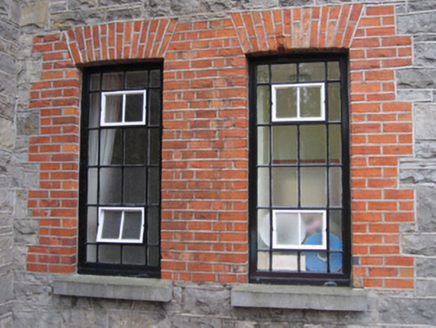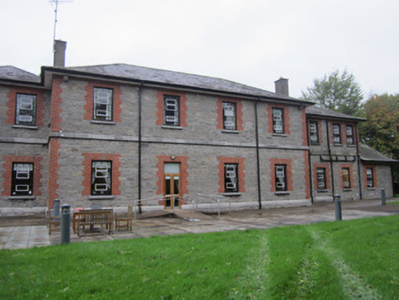Survey Data
Reg No
41303051
Rating
Regional
Categories of Special Interest
Architectural, Social
Previous Name
Monaghan District Lunatic Asylum
Original Use
Building misc
In Use As
Building misc
Date
1865 - 1950
Coordinates
267953, 334155
Date Recorded
15/10/2011
Date Updated
--/--/--
Description
Nine-bay two-storey building, built c.1867, with four-bay central block having recessed flanking bays and single-storey pavilions to each end of south-east façade. These originally connected to return wings at each end latter removed in twentieth century. North-eastern parts built 1940s. Hipped brick-built extension to rear north-west elevation with other smaller flat-roofed extensions. Hipped slate roofs with black clay ridge tiles, sprocketed eaves and valley to double-pile central block. Smooth-rendered chimneystacks with concrete cappings to ends of central block and half-round cast-iron rainwater goods held on overhanging eaves with projecting brick platband beneath. Except for stretcher-bonded brick north-east walls and hipped rear extension, other walls are of squared coursed rubble limestone with block-and-start brick dressings and quoins. Cut-stone projecting string course between floor levels as well as cut-stone cap over projecting plinth on all two-storey elements. Square-headed window and door openings with all those on stone-built elevations having brick arches and surrounds with stone sills and steel frames having centrally pivoting panes. On brick-built elevations, windows have concrete lintels and sills. Replacement glazed timber double-leaf doors on south-east façade with square-headed overlight in brick surround. Surrounded by hard-surfaced car parking within historic Monaghan District Lunatic Asylum complex and set in extensive lawned grounds facing south-east towards mature trees and green space.
Appraisal
This building forms an integral part of the historic St Davnet's Hospital complex which, when constructed in 1867, was the largest institution of its type in Ireland. Loss of its end wings has somewhat reduced the building's historic integrity but it still continues to contribute to the architectural character of the area, sharing its materials and architectural expression with the other principal nineteenth-century hospital buildings on the site. The continued use of this and other structures on the site for a public health service purpose is testament to those who applied appropriate, well thought-out design and a high standard of craftsmanship of the original buildings.



